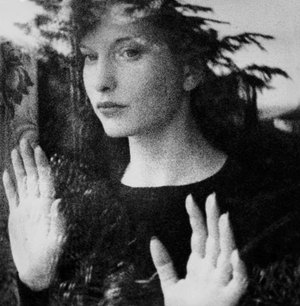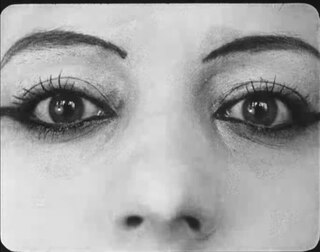Related Research Articles

The Life and Death of 9413: a Hollywood Extra is a 1928 American silent experimental short film co-written and co-directed by Robert Florey and Slavko Vorkapić. Considered a landmark of American avant-garde cinema, it tells the story of a man who comes to Hollywood with dreams of becoming a star; he fails and becomes dehumanized, with studio executives reducing him to the role of an extra and writing the number "9413" on his forehead.

In the arts and in literature, the term avant-garde identifies an experimental genre, or work of art, and the artist who created it; which usually is aesthetically innovative, whilst initially being ideologically unacceptable to the artistic establishment of the time. The military metaphor of an advance guard identifies the artists and writers whose innovations in style, form, and subject-matter challenge the artistic and aesthetic validity of the established forms of art and the literary traditions of their time; thus, the artists who created the anti-novel and Surrealism were ahead of their times.
The Squamish Five were a group of self-styled "urban guerrillas" active in Canada during the early 1980s. Their chosen name was Direct Action. The five were Ann Hansen, Brent Taylor, Juliet Caroline Belmas, Doug Stewart and Gerry Hannah.

Maya Deren was a Ukrainian-born American experimental filmmaker and important part of the avant-garde in the 1940s and 1950s. Deren was also a choreographer, dancer, film theorist, poet, lecturer, writer, and photographer.
Viennese Actionism was a short-lived art movement in the late 20th-century that spanned the 1960s into the 1970s. It is regarded as part of the independent efforts made during the 1960s to develop the issues of performance art, Fluxus, happening, action painting, and body art. Its main participants were Günter Brus, Otto Mühl, Hermann Nitsch, and Rudolf Schwarzkogler. Others involved in the movement include Anni Brus, Heinz Cibulka and Valie Export. Many of the Actionists have continued their artistic work independently of Viennese Actionism movement.

Experimental film or avant-garde cinema is a mode of filmmaking that rigorously re-evaluates cinematic conventions and explores non-narrative forms or alternatives to traditional narratives or methods of working. Many experimental films, particularly early ones, relate to arts in other disciplines: painting, dance, literature and poetry, or arise from research and development of new technical resources.

Italian futurist cinema was the oldest movement of European avant-garde cinema. Italian futurism, an artistic and social movement, impacted the Italian film industry from 1916 to 1919. It influenced Russian Futurist cinema and German Expressionist cinema. Its cultural importance was considerable and influenced all subsequent avant-gardes, as well as some authors of narrative cinema; its echo expands to the dreamlike visions of some films by Alfred Hitchcock.
Lisa Robertson is a Canadian poet, essayist and translator. She lives in France.
William Moritz, film historian, specialized in visual music and experimental animation. His principal published works concerned abstract filmmaker and painter Oskar Fischinger. He also wrote extensively on other visual music artists who worked with motion pictures, including James and John Whitney and Jordan Belson; Moritz also published on German cinema, Visual Music, color organs, experimental animation, avant-garde film and the California School of Color Music.

Wavelength is a 1967 Canadian-American short subject by experimental filmmaker and artist Michael Snow. Considered a landmark of avant-garde cinema, it was filmed over one week in December 1966 and edited in 1967, and is an example of what film theorist P. Adams Sitney describes as "structural film", calling Snow "the dean of structural filmmakers."
Su Friedrich is an American avant-garde film director, producer, writer, and cinematographer. She has been a leading figure in avant-garde filmmaking and a pivotal force in the establishment of Queer Cinema.
Sean Horlor is a Canadian film director, film producer, poet, actor, television producer, columnist and blogger, who co-directs with Steve J. Adams under their production company, Nootka St.
Cosmic Ray is a 1962 American experimental short film directed by Bruce Conner. With both found footage and original material, it features images of countdown leader, a nude woman dancing, a Mickey Mouse cartoon, and military exercises. It is soundtracked by a performance of Ray Charles's "What'd I Say" and has been recognized as the first music video.

The 2008 Toronto International Film Festival (TIFF) was held in Toronto, Ontario, Canada. This 33rd annual festival was from September 4 to September 13, 2008. The opening night gala was the World War I romantic epic Passchendaele from Canadian director Paul Gross.

Mildred "Chick" Strand was an American experimental filmmaker, "a pioneer in blending avant-garde techniques with documentary". Chick Strand contributed to the movement of women's experimental cinema in the early 1960s–1970's. Strand's film making and directing approach incorporates personal elements from her own life experiences and societal forces and realities. The film Elasticity (1976) is an example of Strand's attempts at autobiographical work that also incorporates Strand's specific standpoint on certain social issues. Feminist issues and anthropological inquiries about the human condition are frequent themes in Strand's films. However, because Strand's films and work were often deeply personal and subjective, they were often rejected from male-dominated academic circles of anthropologists and critiqued for being non-academic works.

The Cinematheque, founded in 1972, is a Canadian charity and non-profit film institute, media education centre, and film exhibitor based in Vancouver, British Columbia.
Non-narrative film is an aesthetic of cinematic film that does not narrate, or relate "an event, whether real or imaginary". It is usually a form of art film or experimental film, not made for mass entertainment.
Jane Conger Belson Shimané (1927–2002) was an American experimental filmmaker.
Katsu Kanai is a Japanese experimental and avant-garde film director. The Harvard Film Archive has called him "one of the most vital and inventive filmmakers in the history of Japanese underground film".
References
- 1 2 3 4 Calvin Wharton, "Oliver Hockenhull's Determinations". Cinema Canada , April 1988. pp. 31-32.
- 1 2 Elizabeth Aird, "The New Imagery: Wide use of the avant-garde is just one problem faced by the dedicated folk who make experimental films". Vancouver Sun , January 26, 1990.
- ↑ Katherine Monk, "Movies: Oliver Hockenhull". Vancouver Sun , March 21, 2002.
- ↑ Pat Mullen, "Oscar Winning Doc Leads List of Restored Canadian Classics". Point of View , May 9, 2023.